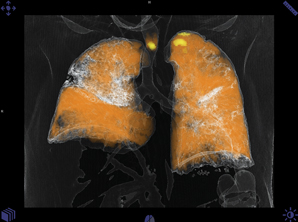
A dual-energy CT shows perfused blood volume in a patient suspected of pulmonary embolism. First proposed 40 years ago, selective energy CT is finally beginning to have a clinical impact through products that either transmit dual-energy CT beams or ones that detect the different energies of photons in a conventional beam.
A battle is taking shape in computed tomography (CT), one that pits the tubes that deliver X-rays against the detectors that record them. It is a fight over how to use X-rays of different energies — variations on the decades-old concept of selective energy CT (SECT), which promise to make diagnoses more accurate and patient management more effective.
In a sense, it is radiology’s version of the matchup between Blu-ray and HD DVD a decade ago. Vendors are squaring off much like Microsoft and Sony did in 2005 with Xbox 360 and PlayStation 3. And the outcome may be similar.
On the exhibit floors of trade shows and in presentations by luminaries, CT’s big three are promoting their own brands of SECT. Siemens offers two products, each of which delivers dual-energy CT. One is built around a single X-ray tube, which uses rapid kVp switching technology to alternate the X-ray tube between two distinctive energies. The other has two X-ray tubes, arranged perpendicular to each other, delivering X-rays at different energies.
GE and Philips are proponents of spectral CT. Rather than delivering two X-ray beams at different energies, they have focused on the detector. Their products fire conventional X-ray beams into detectors that record the different energies of photons included in these beams.
Whether one approach is better than the other is anything but clear. Theoretically, said Hugo Bouchard, Ph.D., senior research scientist at the National Physical Laboratory (NPL) in the United Kingdom, the detector-based approach should have an advantage. Spectral imaging, he noted, is not limited to two energies. “But no one has yet shown the benefits of one energy-selective CT method over the other,” he said, “likely because the technologies are too recent.”
Although SECT was proposed in the 1970s, the technology was not commercially available until less than a decade ago, according to Bouchard. The first peer reviewed clinical results were published in 2006. Since then, clinical research has uncovered a range of potential applications.
Dual-energy and spectral CT may distinguish more effectively than conventional CT tissues of different types, as well as urinary stones of differing chemical composition; enhance stroke evaluation through the improved detection of brain infarcts; help uncover lung cancer lesions by improving contrast-to-noise ratio, overall image quality and tumor delineation; identify calcium-based plaques, even in the presence of iodinated contrast agents; and even reduce artifacts due to beam hardening. Selective energy CT also may, in some instances, reduce radiation dose to patients by reconstructing a “virtual non-contrast CT image” from the contrast-enhanced image by filtering out the iodine in the contrast medium, thereby eliminating the need for a second CT scan.
Bouchard noted that two energies “could be sufficient for our current clinical needs.” If so, spectral CT and its ability to discriminate photons at several energies would offer only “marginal benefit,” he said. Spectral CT may be limiting itself, in this regard. GE describes its approach as “dual-energy spectral CT,” made possible by its detector using “rapid kV switching to acquire the dual-energy samples.” And Philips uses “dual-energy filters.”
The means for obtaining the information, therefore, might matter less than the ability to perform selective energy CT. The gaming industry shows how this might happen.
Ten years ago, Sony and Microsoft were locked in battle over Blu-ray and HD DVD. Blu-ray won. But its victory did not stop Microsoft. Today Xbox One owners can download an app that allows them to play movies on Blu-ray disks, an app that matters less with each passing day as more movies and programs are streamed over the Internet.
The battle over selective energy technologies may be resolved in much the same way. If the concept of SECT proves itself clinically, energy-specific protocols might one day be provided by vendors to suit their machines, which will deliver the goods using whatever means they have handy, much as gaming consoles play movies today.
If so, it will conclude a battle in which everyone, most importantly the patient, wins … a battle that has only begun.
Greg Freiherr has reported on developments in radiology since 1983. He runs the consulting service, The Freiherr Group. Read more of his views on his blog at www.itnonline.com.
